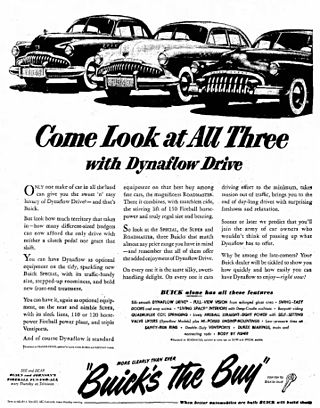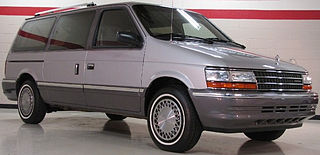Related Research Articles

An automatic transmission is a multi-speed transmission used in motor vehicles that does not require any input from the driver to change forward gears under normal driving conditions. Vehicles with internal combustion engines, unlike electric vehicles, require the engine to operate in a narrow range of rates of rotation, requiring a gearbox, operated manually or automatically, to drive the wheels over a wide range of speeds.

A torque converter is a device, usually implemented as a type of fluid coupling, that transfers rotating power from a prime mover, like an internal combustion engine, to a rotating driven load. In a vehicle with an automatic transmission, the torque converter connects the prime mover to the automatic gear train, which then drives the load. It is thus usually located between the engine's flexplate and the transmission. The equivalent device in a manual transmission is the mechanical clutch.

Dodge Dart is a line of automobiles marketed by Dodge from the 1959 to 1976 model years in North America, with production extended to later years in various other markets.
A semi-automatic transmission is a multiple-speed transmission where part of its operation is automated, but the driver's input is still required to launch the vehicle from a standstill and to manually change gears. Semi-automatic transmissions were almost exclusively used in motorcycles and are based on conventional manual transmissions or sequential manual transmissions, but use an automatic clutch system. But some semi-automatic transmissions have also been based on standard hydraulic automatic transmissions with torque converters and planetary gearsets.

The Chrysler Saratoga is an automobile built by Chrysler. The nameplate was used from 1939 to 1952 and from 1957 to 1960 in the U.S. market, in Canada through 1965, and in Europe from 1989 to 1995. In the beginning, it was introduced as a sport luxury model, using the Straight Eight engine from the Chrysler New Yorker which was more formal, and the Imperial which had graduated to special order limousine.

Hydramatic is an automatic transmission developed by both General Motors' Cadillac and Oldsmobile divisions. Introduced in 1939 for the 1940 model year vehicles, the Hydramatic was the first mass-produced fully-automatic transmission developed for passenger automobile use.

TorqueFlite is the trademarked name of Chrysler Corporation's automatic transmissions, starting with the three-speed unit introduced late in the 1956 model year as a successor to Chrysler's two-speed PowerFlite. In the 1990s, the TorqueFlite name was dropped in favor of alphanumeric designations, although the latest Chrysler eight-speed automatic transmission has revived the name.
Ultramatic was the trademarked name of the Packard Motor Car Company's automatic transmission introduced in 1949 and produced until 1954, at Packard's Detroit, Michigan East Grand Boulevard factory. It was produced thereafter from late 1954, thru 1956 at the new Packard "Utica" Utica, Michigan facility.

Dynaflow was the trademarked name for a type of automatic transmission developed and built by General Motors Buick Motor Division from late 1947 to mid-1963. The Dynaflow, which was introduced for the 1948 model year only as an option on Roadmaster models, received some severe early testing in the M18 Hellcat tank destroyer, which were built in Buick's Flint Assembly plant during World War II. It was also used in the 1951 Le Sabre concept car.
Turbo-Hydramatic or Turbo Hydra-Matic is the registered tradename for a family of automatic transmissions developed and produced by General Motors. These transmissions mate a three-element turbine torque converter to a Simpson planetary geartrain, providing three forward speeds plus reverse.
Ford-O-Matic was the first automatic transmission widely used by Ford Motor Company. It was designed by the Warner Gear division of Borg Warner Corporation and introduced in 1951 model year cars, and was called the Merc-O-Matic when installed in Mercury branded cars and Turbo-Drive when installed in Lincoln branded cars. In contrast to Detroit Gear Division's three band automatic originally designed for Studebaker which became superseded by this unit, a variation of Warner Gear's three-speed unit named Ford-O-Matic continued to evolve later into Cruise-O-Matic named transmissions in 1958 and finally the FMX named transmissions in 1968. This line continued in production until 1980, when the AOD was introduced. Like Ford, variations of this same Borg Warner design were used by other automobile manufacturers as well, such as AMC, International Harvester, Studebaker, Volvo and Jaguar, each of them having the necessary unique adaptations required for the individual applications.
The Powerglide is a two-speed automatic transmission designed by General Motors. It was available primarily on Chevrolet from January 1950 through 1973, although some Pontiac models also used this automatic transmission after the fire at the Hydra-Matic factory in 1953. Powerglides were used extensively on Pontiacs produced for the Canadian market with Chevrolet powertrains. They were also used with Nova engines in the DJ-5A Jeeps produced 1968-1970 by Kaiser-Jeep and widely used as delivery vehicles by the United States Post Office. When introduced on upper-level Chevrolet models in 1950, the Powerglide represented the first automatic transmission offered in a low-priced automobile; in contrast, Ford did not offer their automatic transmission until 1951, while Plymouth car buyers had to wait until 1954. The transmission was simple and very durable, which satisfied customers.
The Super Turbine 300 was a two-speed automatic transmission built by General Motors. It was used in various Buick, Oldsmobile, and Pontiac models from 1964-1969. It was the same transmission marketed under different brand names by each division including ST-300 by Buick, Jetaway by Olds and simply Automatic by Pontiac.
The Ultradrive is an automatic transmission manufactured by Chrysler beginning in the 1989 model year.
The M6 Presto-Matic was a Chrysler Corporation semi-automatic transmission produced from 1946 to 1953. It was a special manual transmission with a fluid coupling. Although it had just two forward gears, an electric overdrive unit was attached and useful in either gear for a total of four forward speeds.
Fluid Drive is the trademarked name that Chrysler Corporation assigned to a transmission driveline combination which replaced the flywheel with a hydraulic coupling and performed the same function as a modern torque converter, only without torque multiplication. A conventional clutch and three- or four-speed manual transmission was installed behind the fluid coupling. Fluid drive was used in many military vehicles produced for the US Armed Forces during the Second World War. It was offered for civilian use from 1939 through 1953 in Chryslers, 1940 through 1953 in DeSotos, and from 1941 through 1954 in Dodge models; a semi-automatic system was optional from Chrysler and Desoto from 1941, and for Dodge from 1949.

The Plymouth Suburban is a station wagon produced from 1949 until 1978.
The name Autostick has been used for a Volkswagen semi-automatic transmission, which is a vacuum-operated automatic clutch system, coupled with a conventional 3-speed manual transmission. The "AutoStick" system designed by Chrysler allows for manual selection of gears with a standard hydraulic automatic transmission, also known as a manumatic.

The second-generation Chrysler minivans are a series of minivans that were manufactured and marketed by Chrysler Corporation in North America and Europe from 1991 to 1995. Officially designated the AS platform by Chrysler, the second-generation minivans were an extensive revision of the first-generation chassis and body. As before, passenger and cargo configurations were sold by Dodge, Plymouth, and Chrysler divisions. The first minivans offered with driver-side airbags and with optional integrated child safety seats, the second-generation Chrysler minivans offered all-wheel drive as an option for the first time; a manual transmission would be offered for the last time in the North American market.
References
- "The Chrysler-Plymouth-Dodge-DeSoto Hy-Drive automatic transmission". Allpar.Com. Retrieved February 22, 2006.
- Flory, J. "Kelly", Jr. American Cars 1946-1959. Jefferson, NC: McFarland & Coy, 2008.